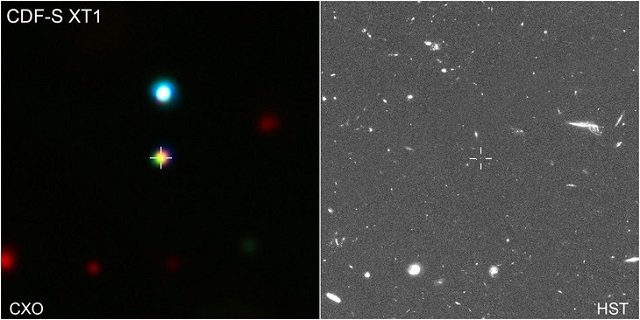
NASA’s Chandra X-ray Observatory has made an extraordinary discovery—a brilliant burst of X-rays in the deepest X-ray image ever captured.
This unexpected find has left researchers fascinated and puzzled, as it appears to originate from a rare and unidentified event that has never been witnessed before.
Niel Brandt, a scientist involved in the study, expressed his excitement, saying, “This surprise discovery was an unexpected bonus while exploring the mysterious world of ultra-faint X-rays.
It’s like winning the lottery and now we have a thrilling new phenomenon to investigate in the coming years.”
Situated within an area of the sky called the Chandra Deep Field-South (CDF-S), this particular X-ray source exhibits extraordinary characteristics. Before October 2014, it remained invisible in X-rays, but suddenly erupted, becoming at least 1,000 times brighter in just a few hours. Remarkably, within a day, the source faded completely and fell below the sensitivity of Chandra.
By analyzing extensive data from the Hubble and Spitzer Space Telescopes, collected over thousands of hours, scientists determined that the event originated from a faint, small galaxy located approximately 10.7 billion light years away from Earth.
For a brief period, this X-ray source emitted a thousand times more energy than all the stars in its galaxy.
The researchers have considered several possible explanations for this mysterious X-ray source. Two of the main hypotheses involve gamma-ray burst (GRB) events.
GRBs are powerful explosions triggered by the collapse of massive stars or the merging of neutron stars with black holes or other neutron stars. When the jet from the explosion points towards Earth, we detect bursts of gamma-rays. As the jet expands, it weakens, producing less intense radiation at X-ray and other wavelengths.
The scientists propose that the CDF-S X-ray source could be a GRB not directed towards Earth or a GRB occurring beyond the small galaxy. Another possibility is that a medium-sized black hole shredded a white dwarf star. However, none of these explanations perfectly aligns with the observed data, emphasizing the researchers’ limited understanding of these phenomena.
The enigmatic X-ray source remained unseen during the extensive observation period of the CDF-S region over 17 years. Furthermore, no similar events have been identified in Chandra’s observations of other parts of the sky.
Distinguishing itself from other unexplained variable X-ray sources, such as those found in elliptical galaxies NGC 5128 and NGC 4636, the CDF-S source exhibits unique properties.
It is associated with the complete destruction of a neutron star or white dwarf and appears approximately 100,000 times more luminous in X-rays.
Additionally, it resides in a much smaller and younger host galaxy, only emerging during a single burst lasting several hours.
Co-author Kevin Schawinski remarks, “We might have witnessed an entirely new type of cataclysmic event. To understand what we’re witnessing, we’ll need to conduct more extensive observations.”
Further investigations using Chandra’s archives, as well as data from ESA’s XMM-Newton and NASA’s Swift satellite, may reveal additional instances of this elusive variable object that have gone unnoticed until now.
Future X-ray observations by Chandra and other observatories, including the planned Chinese Einstein Probe, could uncover similar phenomena originating from other celestial objects.
If the X-ray source resulted from a GRB triggered by the merger of neutron stars or a black hole, it would have also produced gravitational waves.
If such an event were to occur closer to Earth, it might be detectable by the Laser Interferometer Gravitational-Wave Observatory (LIGO).



